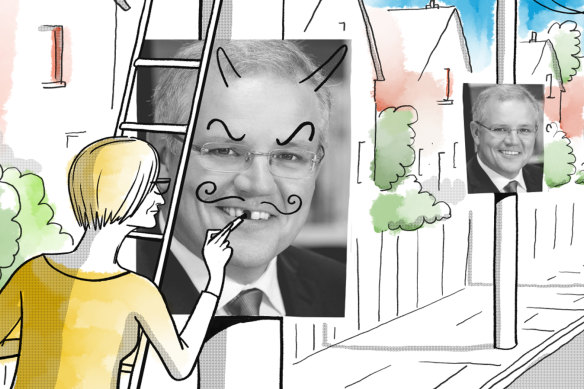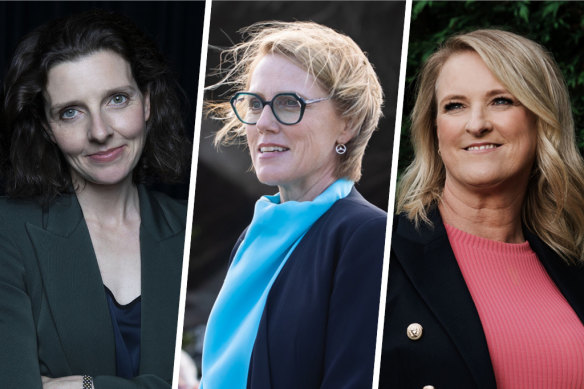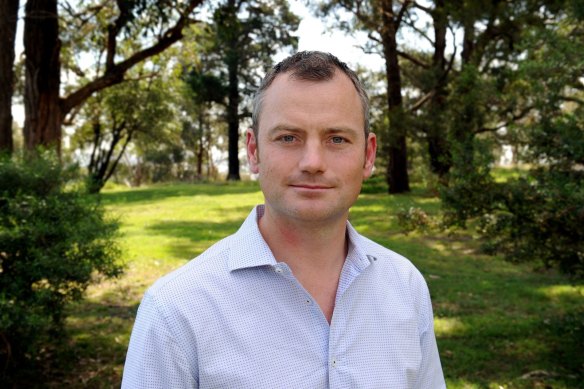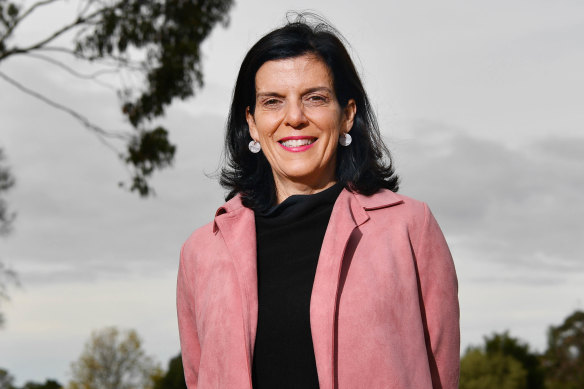This was published 3 years ago
Opinion
Time for a cold shower for those dreaming of independent victories
David Crowe
Chief political correspondentSo many independent candidates are now running at the next election, with so much attention on their campaigns, that the time is right for a cold assessment of their bids for truly seismic victories by toppling incumbent Liberals.
It is time for a cold shower for those who think the mere launch of an independent campaign, even with the promise of money from climate change groups, is enough to shift a relatively wealthy electorate out of its preference for the conservative side of politics.

Independents are taking on Liberal seats in the federal election.Credit: Illustration by Simon Letch
While the campaigns are full of promise on issues like climate, integrity in politics and equality for women, there is no proof – yet – they have any greater momentum than the attempts at every election to take on the major parties.
In fact, the momentum was probably greater at the last election, when the Liberals had just suffered a leadership crisis and there was no pandemic to encourage voters to stick with the devil they know. Incumbency could be even more powerful this time around.
There are four main ways for an independent to succeed in Canberra. The first is to move from state politics (Ted Mack, Rob Oakeshott, Tony Windsor). The second is to quit a political party and move to the crossbench (Julia Banks, Paul Filing, Allan Rocher). The third is to seize a Labor seat when its MP retires (Andrew Wilkie, but also Greens leader Adam Bandt).
The fourth is the method of the moment: to campaign against an incumbent in a Liberal seat. Zoe Daniel and Allegra Spender are just two of the faces of this movement, backed by funding from Climate 200 and its leader, Simon Holmes a Court.
The formula clearly works, especially when the incumbent is unpopular. It helped Rebekha Sharkie replace Jamie Briggs in Mayo, Cathy McGowan replace Sophie Mirabella in Indi (now held by Helen Haines) and Zali Steggall remove Tony Abbott in Warringah.
The essential elements are to replace a man with a woman and a conservative with a moderate – or, to the fundamental point, someone who is not Labor or Green.
But it is rare. McGowan arrived in 2013, Sharkie in 2016, Steggall in 2019. It will not be easy for the campaigners to get one more elected in 2022 and it would be astonishing to see a handful of new ones take the balance of power.
Importantly, Climate 200 has changed the formula. Learning from the failure of several GetUp campaigns at the last election, when conservatives like Peter Dutton comfortably held their seats, the updated movement targets moderate Liberals. This means it is asking voters to throw out Liberals who argued for greater action on climate change (and prodded Prime Minister Scott Morrison to endorse net zero emissions by 2050) and sided against Morrison on same-sex marriage. This is an experiment.

Independent candidates Allegra Spender, Zoe Daniel and Kylea Tink.Credit: Jessica Hromas, Simon Schluter, James Brickwood
It also requires a delicate balancing act in a pandemic when voters may want the certainty of a major party in power. The independents have to appeal to both sides. Their key objective has to be to gain more voters than the Labor candidate in a relatively safe Liberal seat. Defeating the Liberal incumbent on primary votes is unlikely; defeating the Labor alternative is vital. Only then can the independent collect enough preferences to vault ahead of the incumbent and claim the prize.
Or, as one observer puts it: “You have to come second in order to be able to jump.”
This explains the strategic ambiguity from independent candidates about which way they would vote in a hung Parliament. They must allow left-leaning voters to think there is a chance they would support a Labor government. They need Liberal voters to think they could veer towards a Liberal government.
This vagueness looks persuasive to some. Voters have been drifting away from the two major parties for decades and may welcome the prospect of independents holding the balance of power. Yet the strongest support still goes to parties that can form government, even though those parties have dwindling membership and have to rely heavily on public funding.

Simon Holmes a Court has amassed a war chest to spend on independents.Credit: Craig Abraham
So the options are limited for a voter in a wealthy electorate who does not like the way Morrison handles questions about integrity or the treatment of women but prefers a Liberal government that continues support for franking credits, private health insurance and negative gearing.
For some of these voters, even the slightest chance that an independent installs a Labor government will be too big a risk to justify a protest vote. The independent campaign will need much greater momentum, far beyond the hothouse of social media, to overcome that barrier.
Banks, the independent who left the Liberals in 2018 and lost at the 2019 election, knows how hard this can be. She had a very high profile going into the campaign but could not remove Health Minister Greg Hunt. The campaign was dirty at times but the threat to Hunt was never as great as the media made it look. The swing against him was only 1.4 per cent after preferences. He won 55.6 per cent of the two-party vote.
Banks, who is on the Climate 200 advisory council, thinks voters are ready to send a team of independents into the lower house.

Former MP Julia Banks took on Health Minister Greg Hunt in Flinders. Credit: Joe Armao
“There’s a stronger sense of the movement going forward,” she says. “The circuit-breaker can only be the independents holding the balance of power. And I think we’re seeing the beginnings of that circuit-breaker.”
History says otherwise. The sole independent to defeat a Liberal moderate in recent times, Kerryn Phelps, took the seat of Wentworth at a rare moment. She won at a by-election when Malcolm Turnbull had quit Parliament after a leadership spill. The campaign was rocked by the leaking of a report into religious freedom (sparking the debate on schools and LGBTQI students and teachers) and Morrison’s clumsy foreign policy decisions on Israel and Iran.
Back then, in October 2018, the government looked like it needed to be put out of its misery. A slight majority in Wentworth decided to help. Phelps gained 29.2 per cent of the primary vote and overtook the Liberals to win 51.2 per cent after preferences.
At the general election, however, the same voters backed the relatively unknown Liberal candidate, Dave Sharma, who increased his primary vote from 43.1 per cent in October to 47.4 per cent in May. The choice hardened over who should form government. The big debate was about tax – or, in other words, self-interest. Phelps increased her primary vote but Sharma won 51.3 per cent in the end.
The independent campaigns will shape the election even if its candidates do not win. The movement has given the Liberals urgent reasons to choose women in key seats. It is also forcing the Liberals to divert money and time into seats they would otherwise consider safe.
The movement also captures a mood of community frustration – for some, anger and outrage – at business as usual in Canberra. That makes it a powerful force. Even so, the vibe is a poor guide to an election outcome. Media attention is not a reliable indicator, either.
History is a better guide. It shows the chances for most of the independents will be very, very slim. The movement will be lucky to get two in 2022. That would be twice as many as usual.
The Opinion newsletter is a weekly wrap of views that will challenge, champion and inform. Sign up here.